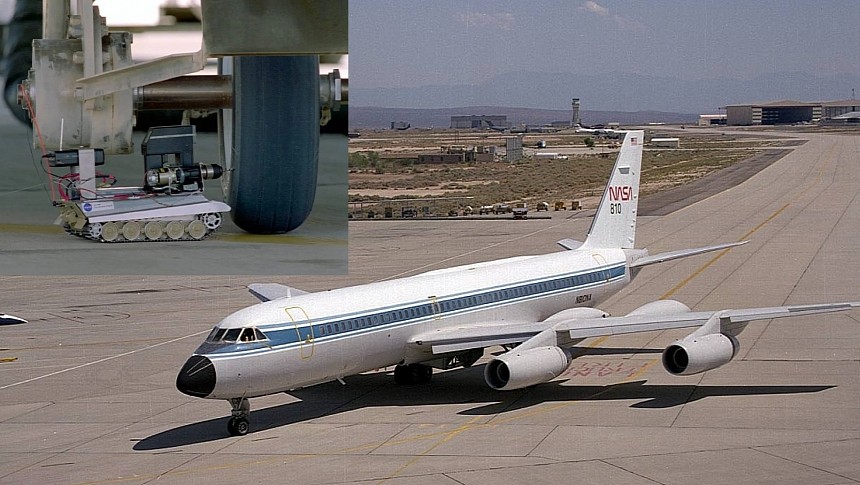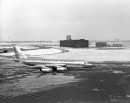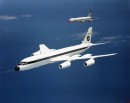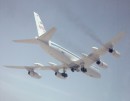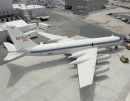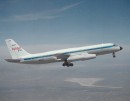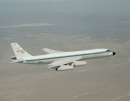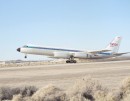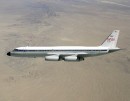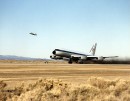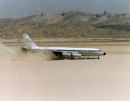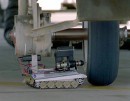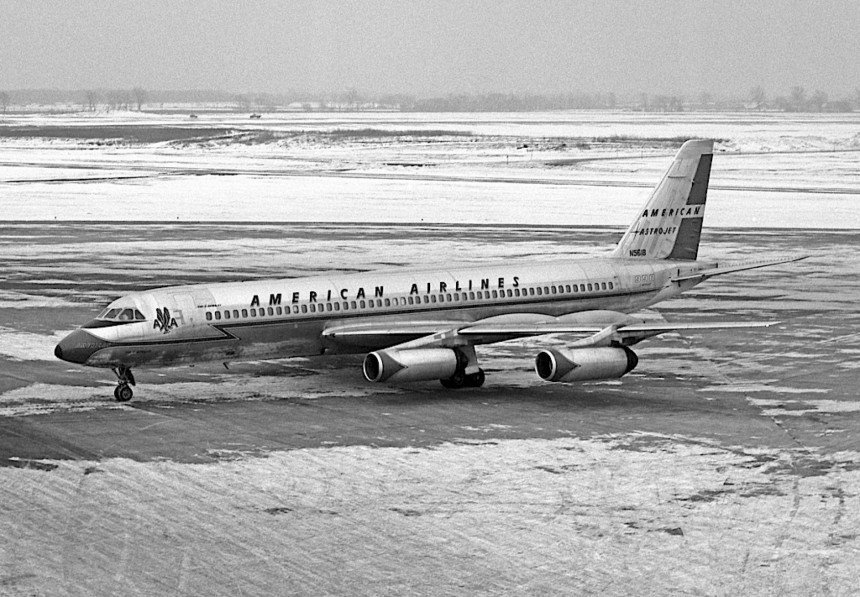The internet at large has been ablaze recently with stories about a radio-controlled scale model of a World War II German King Tiger tank whose job was to drill holes in over-pressurized Space Shuttle tires during ground tests. Now, whether a Second World War German tank serving as the basis for this vehicle has any explanation other than NASA engineers being the most lovable dorks in the Milky Way or not is up for some debate. But mixed up in the social media circus is the aircraft wearing these special tires so brimming with PSIs that it'd kill anyone within a radius of a few dozen feet.
This is the story of the Convair 990 Coronado, a failed commercial passenger jetliner that had a miraculous second renaissance working for NASA. Only then did it receive the above-mentioned RC Tiger tank robot buddy we all know and love. But at the start of the 990 program in the late 1950s, Convair genuinely wanted to re-invent the wheel with the jet. At the time, American Airlines, in particular, was extra keen on a long-haul, narrow-body jetliner capable of flying across the Continental U.S. from New York to Los Angeles without stopping to refuel.
Of course, existing airframes like the Boeing 707 and Douglas DC-8 could already manage this feat in ideal conditions. But managing this feat in a strong headwind, flying specifically from the east coast to the west coast, was easier said than done in the early days. By the turn of the 60s, Convair was already intimately familiar with jet power. Early successes with the jet-piston hybrid B-36 Peacemaker strategic bomber, the F-102 Delta Dagger jet fighter, and the B-58 Hustler jet bomber had already established the company as a force within the military side of things.
But at least at first, nothing Convair manufactured in the civilian sector stood a chance of meeting American Airline's expectations. Convair's first jet airliner, the 880, wasn't a sub-par aircraft by any means. With two purpose-built civilian variants of the B-58 Hustler's General Electric J79 engines under each wing, the 880 was a serviceable, albeit not perfect, civil passenger liner platform. But with a relatively paltry passenger capacity of 110 passengers, a typical Douglas DC-8 trimmed in an all-economy seating arrangement could easily double the 880's passenger count.
What Convair required was an all-new airliner platform on the basis of the 880 but with many of its design's shortcomings addressed to satisfy American Airline's requirements. What Convair ultimately devised to make this happen was initially dubbed the Convair 600 to denote its targeted top speed of 600 mph. With dimensions of 42.6 meters (139ft, 9in) long and a 37-meter (120 ft) wingspan, the 600 was still a bit smaller than a DC-8 or 707. But one vital area the Convair 600 bested its rivals from McDonnell-Douglas and Boeing was every nine-year-old's favorite metric, raw speed.
With the same fighter jet-sourced General Electric CJ-805s as the smaller 880, what was named the 990 Coronado after its first flight in January 1961 could fly upwards of 30 mph (48.2 kph) faster than its contemporaries. That might not sound like anything to write home about. But compounded against a six-to-seven-hour transcontinental flight breaking through a headwind the entire way, that little extra speed saved valuable time for the Coronado's passengers. At least, it did in theory. But a proverbial long-wheelbase option of the 880, its 990 big brother was not.
In an effort to cut through turbulent headwinds with ease during east-to-west jaunts across the U.S., Convair integrated one anti-shock body behind each of the jet's four engines. These trademark features blended into the Corronado's upper wings also had the benefit of increasing its critical Mach speed. I.e., the lowest possible point before the airflow over portions of an aircraft in flight reaches the speed of sound but not the plane itself, leading to friendlier high-speed handling characteristics. Add in a cabin not all that much smaller than a DC-8 or 747, and it looked like Convair had a formula for success.
Well, it turns out strong numbers and positive optics don't always translate to success. In spite of the lofty goals, American Airlines deemed the Coronado's performance as not quite meeting their requirements. To make things worse, Coronados, which entered service after American Airlines reduced its production order citing failed expectations, came only in a trickle. Only 37 990 Coronado airframes were manufactured between 1991 and 1963, with a small amount leaving the factory as upgraded 990A models with a higher cruise speed, among other refinements.
Only American Airlines and Switzerland's national airline, Swissair, operated the Coronado in large numbers. Both companies couldn't help but notice the jet was more than a bit thirsty for fuel. Like a journeyman minor-league baseball player, the Coronado bounced around with smaller airlines, with a stint as a member of Israel's flag carrier El Al, admittedly, until 1987. Convair would never build another airliner before dissolving in 1996. For most airliners, that'd be the point the story ends. All the airframes piled up in a boneyard, rusting back into the Earth or locked up in museums in a few lucky cases. But fate decreed that the 990 Coronado's life story didn't end with its retirement from passenger service.
In 1993, it was NASA of all people who came calling to give one lucky Convair 990A one final assignment. It was only at this stage that the aircraft finally met its robot tank buddy. The concern in question was the Space Shuttle, which was in the midst of a comprehensive fleet overhaul in the early 1990s. One of the most important concerns regarding the Space Shuttle in its early career was its landing gear tires. When coming in to land at the Kennedy Space Center in Florida at speeds nearing 300 mph (482 kph), the forces exuded on a Shuttle's nitrogen-filled front and rear tires inflated to upwards of 370 PSI (25.5 Bar) dwarfed even the largest, fastest airliners.
The sole-surviving airworthy Convair Coronado's final assignment was to test these tires straight from their Michelin factory to destruction. Indeed, these tires often went kaboom during and after landings. Suffice it to say, handling the tires once they were safe on the ground was a job for something less squishy than people. It's here where NASA's CR-990 Tire Assault Vehicle comes into its own. Derived from an RC kit made by the Japanese toymaker Tamiya, NASA engineers modified one model to sport a DeWalt drill with an integrated black and white camera powered by a Black and Decker battery.
The CR-990 would approach the dangerously inflated prototype Space Shuttle tires fresh from their test flight before boring holes in the tire wall, often causing large explosions. Between February and August 1995, the CR-990 survived nine separate tire detonations. Today, the Tire Assault Vehicle is stored in a plexiglass case at the NASA Armstrong Flight Research Center in California, while the NASA 990 Coronado serves as a gate guard at the Mojave Air and Space Port in Mojave, California.
It only goes to prove that even an airliner that totally failed at its objective to the point its builders never tried again can still provide valuable service under the right circumstances. In the case of one Coronado, those circumstances weirdly included a tank.
Of course, existing airframes like the Boeing 707 and Douglas DC-8 could already manage this feat in ideal conditions. But managing this feat in a strong headwind, flying specifically from the east coast to the west coast, was easier said than done in the early days. By the turn of the 60s, Convair was already intimately familiar with jet power. Early successes with the jet-piston hybrid B-36 Peacemaker strategic bomber, the F-102 Delta Dagger jet fighter, and the B-58 Hustler jet bomber had already established the company as a force within the military side of things.
But at least at first, nothing Convair manufactured in the civilian sector stood a chance of meeting American Airline's expectations. Convair's first jet airliner, the 880, wasn't a sub-par aircraft by any means. With two purpose-built civilian variants of the B-58 Hustler's General Electric J79 engines under each wing, the 880 was a serviceable, albeit not perfect, civil passenger liner platform. But with a relatively paltry passenger capacity of 110 passengers, a typical Douglas DC-8 trimmed in an all-economy seating arrangement could easily double the 880's passenger count.
What Convair required was an all-new airliner platform on the basis of the 880 but with many of its design's shortcomings addressed to satisfy American Airline's requirements. What Convair ultimately devised to make this happen was initially dubbed the Convair 600 to denote its targeted top speed of 600 mph. With dimensions of 42.6 meters (139ft, 9in) long and a 37-meter (120 ft) wingspan, the 600 was still a bit smaller than a DC-8 or 707. But one vital area the Convair 600 bested its rivals from McDonnell-Douglas and Boeing was every nine-year-old's favorite metric, raw speed.
In an effort to cut through turbulent headwinds with ease during east-to-west jaunts across the U.S., Convair integrated one anti-shock body behind each of the jet's four engines. These trademark features blended into the Corronado's upper wings also had the benefit of increasing its critical Mach speed. I.e., the lowest possible point before the airflow over portions of an aircraft in flight reaches the speed of sound but not the plane itself, leading to friendlier high-speed handling characteristics. Add in a cabin not all that much smaller than a DC-8 or 747, and it looked like Convair had a formula for success.
Well, it turns out strong numbers and positive optics don't always translate to success. In spite of the lofty goals, American Airlines deemed the Coronado's performance as not quite meeting their requirements. To make things worse, Coronados, which entered service after American Airlines reduced its production order citing failed expectations, came only in a trickle. Only 37 990 Coronado airframes were manufactured between 1991 and 1963, with a small amount leaving the factory as upgraded 990A models with a higher cruise speed, among other refinements.
Only American Airlines and Switzerland's national airline, Swissair, operated the Coronado in large numbers. Both companies couldn't help but notice the jet was more than a bit thirsty for fuel. Like a journeyman minor-league baseball player, the Coronado bounced around with smaller airlines, with a stint as a member of Israel's flag carrier El Al, admittedly, until 1987. Convair would never build another airliner before dissolving in 1996. For most airliners, that'd be the point the story ends. All the airframes piled up in a boneyard, rusting back into the Earth or locked up in museums in a few lucky cases. But fate decreed that the 990 Coronado's life story didn't end with its retirement from passenger service.
The sole-surviving airworthy Convair Coronado's final assignment was to test these tires straight from their Michelin factory to destruction. Indeed, these tires often went kaboom during and after landings. Suffice it to say, handling the tires once they were safe on the ground was a job for something less squishy than people. It's here where NASA's CR-990 Tire Assault Vehicle comes into its own. Derived from an RC kit made by the Japanese toymaker Tamiya, NASA engineers modified one model to sport a DeWalt drill with an integrated black and white camera powered by a Black and Decker battery.
The CR-990 would approach the dangerously inflated prototype Space Shuttle tires fresh from their test flight before boring holes in the tire wall, often causing large explosions. Between February and August 1995, the CR-990 survived nine separate tire detonations. Today, the Tire Assault Vehicle is stored in a plexiglass case at the NASA Armstrong Flight Research Center in California, while the NASA 990 Coronado serves as a gate guard at the Mojave Air and Space Port in Mojave, California.
It only goes to prove that even an airliner that totally failed at its objective to the point its builders never tried again can still provide valuable service under the right circumstances. In the case of one Coronado, those circumstances weirdly included a tank.
